Early History
The first pinball machines were introduced during the early 1930s and were based on a French tabletop game known as bagatelle. These early pinballs didn’t have flippers. Rather, they were played as games of chance in which the ball was launched onto an inclined playfield, and except for some gentle nudging of the machine itself, the player had no control over the ball’s final outcome. Money and prizes were issued if the ball happened to land in certain slots, resulting in pinballs becoming a wildly popular form of entertainment. This triggered a national debate regarding the legality of such machines and if they represented gambling or not. Stories emerged of school children spending all their lunch money on pinballs and the fact that many of the early machines were manufactured in Chicago (which at the time was considered the nexus of organized crime) certainly didn’t help ease any of the controversy. As a result, pinballs soon became outlawed in many cities and states throughout the country.
Pinball machines initially remained legal in Washington State, though different local municipalities began questioning how pinball machines should be enforced. In Seattle – where pinballs proved to be especially popular – the City Council quickly recognized the potential revenue that could be realized with such devices and imposed a hefty licensing fee for each pinball machine that operated within the city limits. Despite the large sums of money that pinballs generated for the city, local officials often found themselves in a quandary over their legal status. The matter became somewhat settled in 1937 when Governor Clarence D. Martin (1886-1955) signed legislation that banned all pinball machines, except where the element of skill predominated, and also mandated that all legal pinball operators were to pay a state business tax on each of their machines. Because it was never explicitly explained how the issue of skill versus luck was to be determined, the legal status of pinball machines would remain murky for the next few decades, with different towns and counties establishing their own interpretations into law. In most places, pinballs were generally tolerated due to the high amount of tax revenue they generated.
One of the earliest pinball enterprises in Seattle was the Shyvers Coin-Automatic Co., which was opened by Kenneth Shyvers (1899-1976) in 1934 and served as the city’s top distributor for local coin-operated machines. Shyvers was known for designing some of the earliest known pinball machines and strongly campaigned against their criminalization, once remarking to the local press, “There was never any intention that these machines should be used for any purposes other than games of skills.” (Orders Issued on Lotteries)
By the early 1940s, the immense popularity of pinball machines had resulted in taxation at the city, county and state levels. More than half of all revenue collected through the state’s pinball tax came from King County. This prompted local pinball operators to begin using different techniques to help falsify the amount of their reportable earnings. One such method involved boring a hole in the machine and then inserting a device that would prevent the machine from recording payment. Other times, pinball operators would skim the profits by using a special key which allowed the game to operate without the use of a coin. Amongst pinball operators, these particular tricks of the trade became known as “milking,” which set the stage for one of the region’s first pinball rackets.
Beginning in 1942, William R. Forman (1913-1981) and his business partner, Armador “Army” Seijas (1907-1966), co-owned Bremerton Amusement Co. which operated a number of pinball routes in Kitsap County. The two men intentionally chose to establish their pinball business in the Bremerton area in order to take advantage of all the sailors and shipyard workers active in that region during World War II. The business proved to be extremely successful and Forman parlayed all his pinball earnings into purchasing a number of Seattle movie theaters as well as several popular drive-in theaters. In 1953, both men were criminally indicted when it was revealed that they had significantly underreported their 1940s pinball revenue in order to avoid paying their full share of taxes. They would both be found guilty of tax evasion and sentenced to 5 years in prison. Despite his criminal record, Forman would later establish the Pacific Theater movie chain and become a prominent theater magnate.
Tolerance Policy
Seattle has a long and conflicting history of how it has enforced such things as gambling, liquor and prostitution. Under the “open town” policies of former mayor, Hiram Gill (1866-1919), vice was generally tolerated as long as it was discreetly conducted in officially sanctioned locations. Additionally, the Seattle Police Department had a known record of corruption within its ranks in which payoff money was expected from local vice operators who wished to avoid arrest. In exchange, the police helped to maintain order amongst such establishments and this extortion system was therefore seen as an effective means of controlling crime.
In the late 1940s, under the mayorship of William F. Devin (1898-1982), Seattle officially introduced what became known as “tolerance policy,” whereby police bribes were replaced by an official licensing system, and certain gambling – such as pinballs, punchboards and low-stakes cardrooms – were allowed to operate as long as all licensing fees were paid and everything remained within the parameters of the law. This flew directly in the face of state gambling laws, but the logic was that widespread police graft could be replaced with a new system of “officially condoned illegality” (Seattle Justice) which could help keep the city coffers nice and full while also encouraging vice establishments to police themselves.
The master licensing system that emerged from Seattle’s tolerance policy was further designed to prevent criminal activity. Each applicant who wanted a gambling license was fingerprinted and required to have lived in King County for at least 5 years in order prevent out-of-town crime rackets from moving in. Despite their best intentions, city leaders had little idea about what unintended consequences lay ahead.
The Seattle Pinball Bombings
In the mid-1950s, a conglomerate of Seattle pinball operators formed a trade organization known as Amusement Association of Seattle (A.A.S.). The group’s overall mission was to prevent any one person or group from taking over Seattle’s thriving pinball market. This was during the height of tolerance policy, so A.A.S. sought to keep the local pinball industry within respectable limits. There were rules and agreements that all members were expected to follow such as not allowing juveniles to play their machines, nor operating any pinballs near schools or churches.
A.A.S. was presided over by its secretary-treasurer, Fred Galeno (1895-1991), who maintained a close relationship with local Teamster’s Union leader, Frank Brewster (1897-1996). Brewster was a Seattle native who had become head of the powerful Western Conference of Teamsters which, at the time, represented nearly 400,000 Teamster members. This alliance between A.A.S. and the city’s most powerful union gave the group almost complete control over Seattle pinballs. Many of the city’s top taverns formed exclusive agreements with Galeno’s organization in which they only carried amusement devices from licensed A.A.S. operators. The irony, of course, was that A.A.S. had originally formed to prevent any one entity from taking over the city’s pinballs, though they now enjoyed a near monopoly. Before long, A.A.S. used their dominance to exploit the local pinball industry by such things as price fixing and selecting who was able to operate their pinballs and jukeboxes at which locations.
In 1956, the Tacoma City Council declared pinball machines a “public nuisance,” and voted 7-to-2 in favor of banning them outright. That same year, Gordon Clinton (1920-2011) won the election for Seattle mayor, and despite running as a reformist candidate, he quietly endorsed tolerance policy which allowed pinballs to continue operating within the city limits.
A.A.S. grew its operations amid increasing reports that workers from the Teamsters Union were intimidating tavern owners into carrying their machines. Their primary competition at the time was the notorious Colacurcio Brothers Amusement Inc., which ran one of the city’s largest pinball and jukebox operations. It was owned by a trio of siblings – Sam (1925-2015), William (1921-2012) and Frank Colacurcio (1917-2010) – who were known for using strong-arm tactics to convince property owners to carry their machines. However, this was now becoming increasingly difficult thanks to A.A.S.’s growing dominance. It didn’t take long for tensions to start forming between the two groups.
The first skirmish in this growing feud took place on October 11, 1957, when a late-night bomb ripped apart the Century Distributing building - a pinball and jukebox business in the Queen Anne neighborhood. The blast of the bombing was so powerful that the building’s concrete foundation was pushed out by almost two feet, and its entire inventory of pinballs, jukeboxes and coin-operated devices were completely destroyed. The owner told investigators that he could not think of anyone having any motives for such an act, though the fact that his business had assisted A.A.S. in taking several lucrative pinball locations away from the Colacurcio brothers did not go unnoticed by investigating officials.
The following month, Frank Colacurcio was charged with “threat of bodily harm” after three different Seattle tavern owners claimed that they had each been threatened with physical assault if they didn’t carry Colacurcio-owned machines. There were also reports of predatory loan sharking, in which money would be loaned to tavern owners in exchange for exclusive pinball and jukebox rights. Other times, “match bombs” would be placed under rival jukeboxes. This involved putting a lit cigarette on an open book of matches and when the cigarette burned down and reached the match heads, it would set off a big flare and start a fire underneath, usually destroying the machine’s wiring. With concerns steadily growing over the increasing lawlessness of local pinball rackets, the Seattle Police Department issued a public statement declaring, “We will not allow gangsterism to gain a foothold in this community, nor will we permit intimidation of any citizen by threats or violence.” (Jukebox ‘War’ Curbed)
The Seattle City Council was also prompted to reconsider how pinball machines should be enforced, and in May of 1958, they voted unanimously against the renewal of pinball licenses for William Colacurcio, who was also ordered to sell his pinball interests. Two months later, on July 24, 1958, Mayor Clinton signed a pinball and jukebox ordinance into law which tightened regulations on such machines, including a limit on how many pinball licenses would be issued for each individual operator.
On the evening of January 23, 1959, the Pioneer Card Company was the site of a second bombing. The business, located next to the Smith Tower, manufactured and sold dice, playing cards and assorted gambling equipment. The blast blew out all the windows and sent the front door hurling out into the street. Police eventually determined that a stick of dynamite had been dropped through the mail slot.
The following month, it was revealed that the Colacurcio brothers were getting around Seattle’s pinball regulations by operating dummy corporations. In response, the Seattle City Council revoked the licenses of any coin-operated businesses with known connections to the Colacurcio syndicate. This included Ken Shyvers’ downtown jukebox business, which had also been caught operating unlicensed machines. A couple years prior, Shyvers had been indicted for attempting to bribe a Washington State Supreme Court Judge involved in an unrelated case. With such legal troubles steadily mounting, Shyvers would eventually leave the coin-op business altogether and become a home contractor.
On the night of February 18, 1960, Fred Galeno‘s car was bombed outside his Queen Anne home. He was asleep in his bedroom at the time, so escaped any injuries, though the blast was described as “deafening.” and could be heard as far as two miles away. The incident triggered an immediate response from Mayor Clinton who issued a public statement declaring that he would seek to abolish pinball machines outright if any of the bombings turned out to be pinball-related. Six Seattle detectives were promptly assigned to the case and the F.B.I. even launched their own investigation, with the remains of Galeno’s car being sent to a special forensics’ lab in Washington D.C.
The timing of Galeno’s car bombing also drew suspicion as it took place during a contentious mayoral election. Clinton’s political opponent, Gordon Newell (1913-1991), had made public statements denouncing the mayor’s tough stance towards pinballs, arguing that such strict controls had only made things worse. In the early morning hours of March 5, 1960, Newell would find himself the target of the next bombing when his sports car (an Austin-Healy) was destroyed by an explosion in front of this house. Newell attributed the incident to his recent statements about the pinball industry, though others speculated that the bombing was intended to politically embarrass the incumbent mayor. Despite whatever the bomber’s intentions may have been, Clinton ended up winning his bid for re-election. Newell, in turn, would exit the political stage and become the published author of such local history books as “Totem Tales of Old Seattle'' and ”Westward to Alki.”
On July 16, 1960, the Michael Distributing Company – the largest pinball distributor in the state of Washington – was the site of the fifth and final bombing. Once again, dynamite had been used as an apparent means of intimidation. The damage was substantial, prompting a harsh response from Mayor Clinton, who announced that if the bombings weren’t solved within a month that he would seek a permanent pinball ban. It would later be revealed that the owner of the business, John J. Michael (1898-1983), was strongly affiliated with A.A.S. Fred Galeno even offered a $6,000 reward for information leading to the arrest and conviction of any persons responsible for the bombings.
A week later, the Seattle Police Department began using lie detectors to question local pinball operators, though were unable to turn up any solid leads. Meanwhile, the mayor ratcheted up his demands that pinball machines be banned completely, arguing that they had been tolerated in the city for over thirty years but the industry had now proven itself to be reckless and dangerous. On September 20, 1960, the City Council voted 8-to-1 to officially reject the mayor’s request to ban pinballs, though it was noted by the local press that such machines were earning the city as much as $500,000 in annual licensing and tax revenue.
The Scandals of the ‘60s
In January of 1962, the issue of pinballs gained renewed interest when the Seattle Police Department announced that, in accordance with state law, they would begin closing any establishments found with illegal gambling devices. This prompted the City Council to quickly enact a policy in which “amusement only” pinball machines could still operate within the city limits as long as they didn’t offer any monetary payouts. Meanwhile, at the state level, the Washington State Senate voted 32-to-15 in favor of permitting pinballs to operate on a “local option” basis, meaning that cities could decide for themselves if such devices were to be allowed within their jurisdiction.
In 1963, amid all this political activity, a federal grand jury was convened in downtown Seattle as part of an ongoing investigation of the city’s pinball industry, eventually leading to the indictments of Fred Galeno and John J. Michael. They were both charged with “overt acts” related to political payoffs which were used for “making payments to maintain a situation whereby gambling on pinball machines in Seattle could continue.” (Pinball Protection). Galeno and Michael would each be found guilty, resulting in a $3,500 fine and a year of probation. Soon after, both men would retire from the pinball industry, setting the stage for the next generation of pinball rackets.
By the mid-1960s, pinballs continued to flourish as “for amusement only” devices, though it was widely understood that most existing pinballs were still being used for gambling and were bringing in as much as $6 million per year. The Colacurcio brothers still operated pinballs and jukeboxes, though they had also branched out into other ventures including bars, nightclubs and some of Seattle’s earliest strip clubs. A.A.S. had dissolved upon Galeno’s retirement from the pinball industry, with a new association of King County pinball operators known as Farwest Novelty Co. taking their place. Farwest Novelty was headed by Ben Cichy (1898-1969), and they controlled the master licenses for over two thousand pinball machines, pool tables, and bowling games throughout the Seattle region. The local press dubbed Cichy as “the pinball king.”
In 1968, the Seattle Post-Intelligencer, Seattle Magazine and KING-TV joined forces in a joint investigation regarding high-level payoffs and corruption in King County. The ongoing investigation resulted in a scathing news report, which broke on August 21, 1968, in which it was revealed that secret visits had taken place between Ben Cichy and King County Prosecutor, Charles O. Carroll (1906-2003). The impropriety of their clandestine meetings was further heightened by the fact that legal opinions issued by Carroll had allowed Cichy’s organization to enjoy a near monopolistic control of the local pinball industry. After the news broke, Carroll refused to answer any question from the local media regarding the story.
The report spurred Washington State Attorney General, John J. O’Connell (1919-1998), to request that Governor Dan Evans (b. 1925) grant him the legal powers to conduct a thorough investigation of the matter. Evans initially declined this request, stating that it was too preliminary for such things. Later that year, it was announced that O’Connell had received the nomination to be the Democratic challenger against Evans’ bid for re-election as the Republican incumbent. Unsurprisingly, the pinball scandal became a major campaign issue between the two men, with Evans claiming that O’Connell’s investigation into Carroll was politically driven.
Evans would go on to win re-election as governor and afterwards would hand the Carroll and Cichy investigation over to Attorney General-elect, Slade Gorton (1928-2020). However, on May 30, 1969, before any amount of significant investigation could take place, Ben Cichy was found drowned in shallow waters near his Lake Washington home. His death would be ruled accidental, though there were many suspicions about the timing of the event, especially given that Cichy was noted to be an excellent swimmer. Gorton would later condemn Carroll’s refusal to answer any questions about the Cichy scandal, but ultimately concluded that there was no evidence of any extensive corruption.
Pinballs Go Mainstream
In 1970, former King County Sheriff, Tim McCullough, would be indicted by a federal grand jury after disclosures were made about McCullough receiving improper financial contributions from Frank Colacurcio and Ben Cichy. That same year, Charles O. Carroll would mount a bid for re-election as King County Prosecutor. During the campaign, Carroll continued in his refusal to discuss his relationship with Ben Cichy and would eventually lose the election to his challenger, Christopher T. Bayley.
Upon assuming his duties as the new County Prosecutor, Bayley launched an investigation into ongoing issues of corruption, resulting in the indictments of Carroll, as well as 18 other past and present city officials, including a former Seattle City Council president and an ex-Seattle police chief. The charges were “conspiracy of governmental entities” in connection with payoffs related to gambling, bribery and prostitution. Carroll, along with most of the other defendants, would eventually be found not guilty of the charges; though his previous record of public service would be forever tarnished by the scandal.
These indictments would serve as the ending chapter for Seattle’s so-called “pinball war” which, over the years, represented many different factions pitted against each other: the mayor vs. city hall; state government vs local municipalities; and unionized pinball operators vs. local crime syndicates. In the late-1960s, it even became a politically divisive issue between the two candidates for Washington state governor. The string of bombings that epitomized this era of Seattle history were never officially solved and, to this day, remains a sordid chapter in the city’s past.
As the last of these scandals unfolded, the first coin-operated video games started appearing on the scene and pinballs would finally shed their illicit reputation and gain mainstream acceptance as novelty games played for amusement and fun. And while Seattle once served as one of the nation’s hotbeds for pinball-related vice, things have now gone full circle. The city currently boasts its own pinball museum, players of the game compete against one another at local competitions, and pinball machines – now seen with nostalgic fondness – are once again a regular feature at area taverns.
(This originally appeared as a piece I wrote for HistoryLink.org)




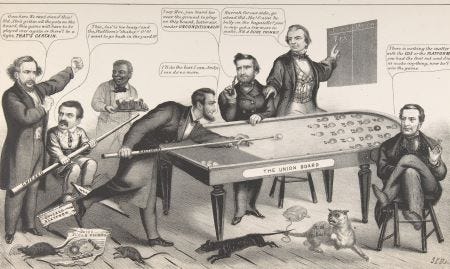

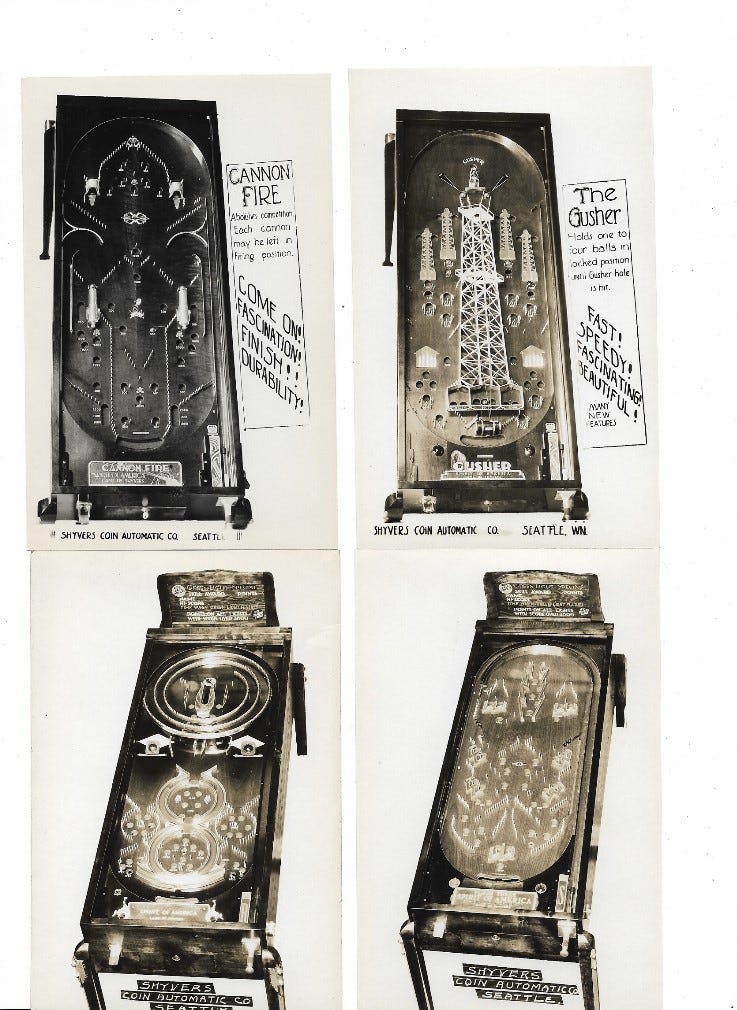

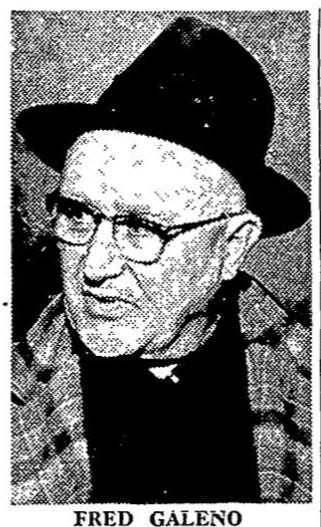
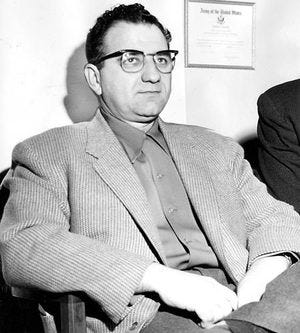
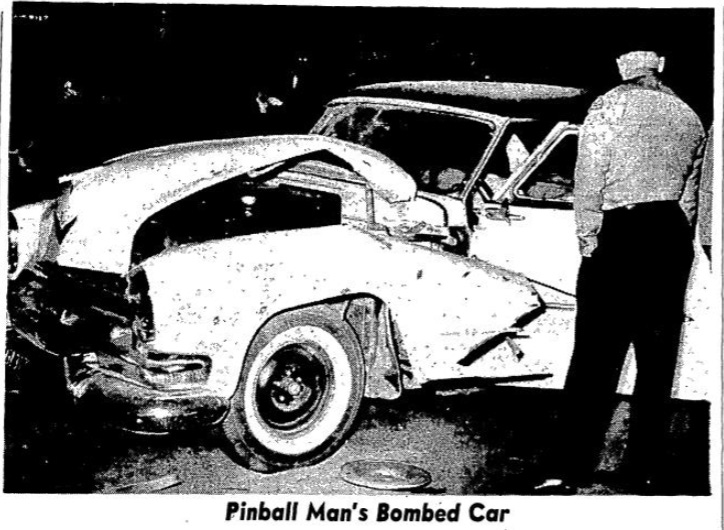
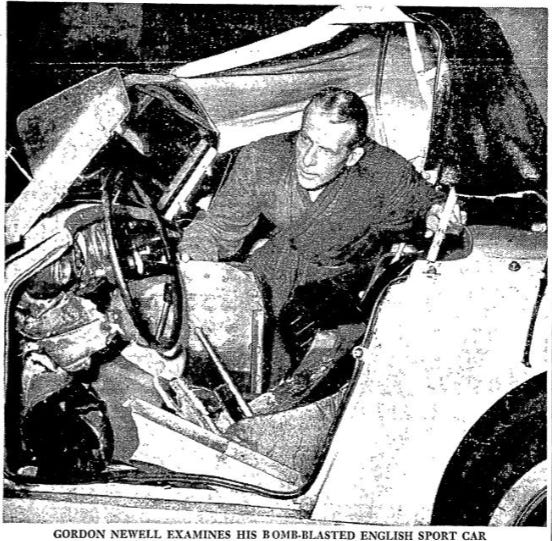

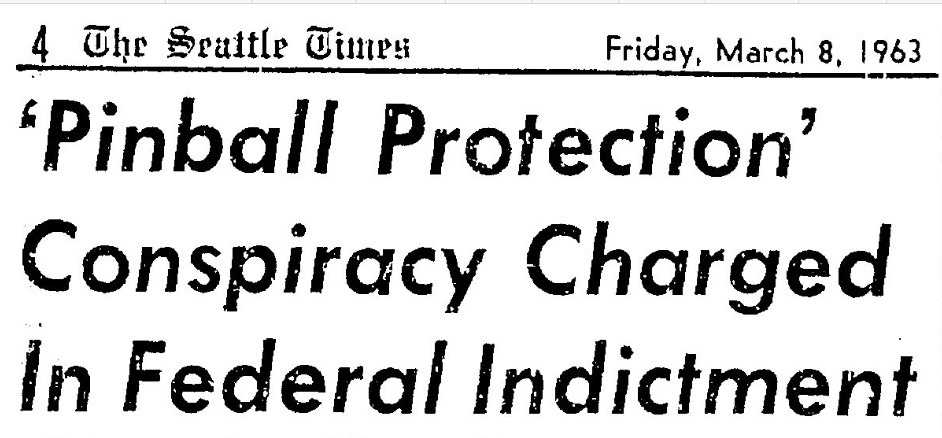
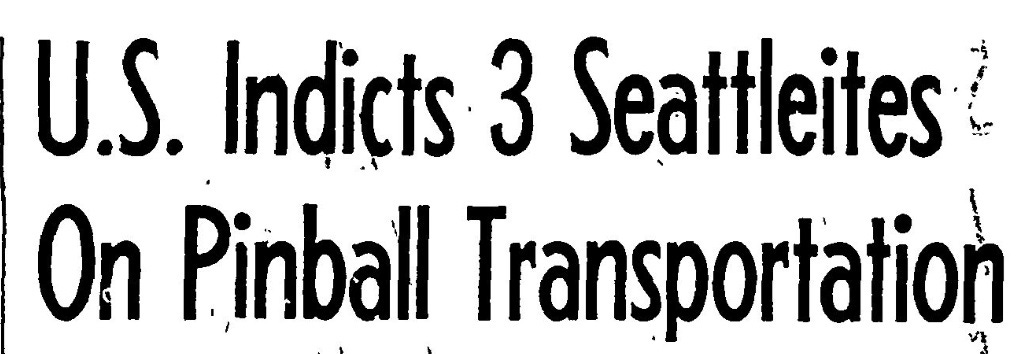

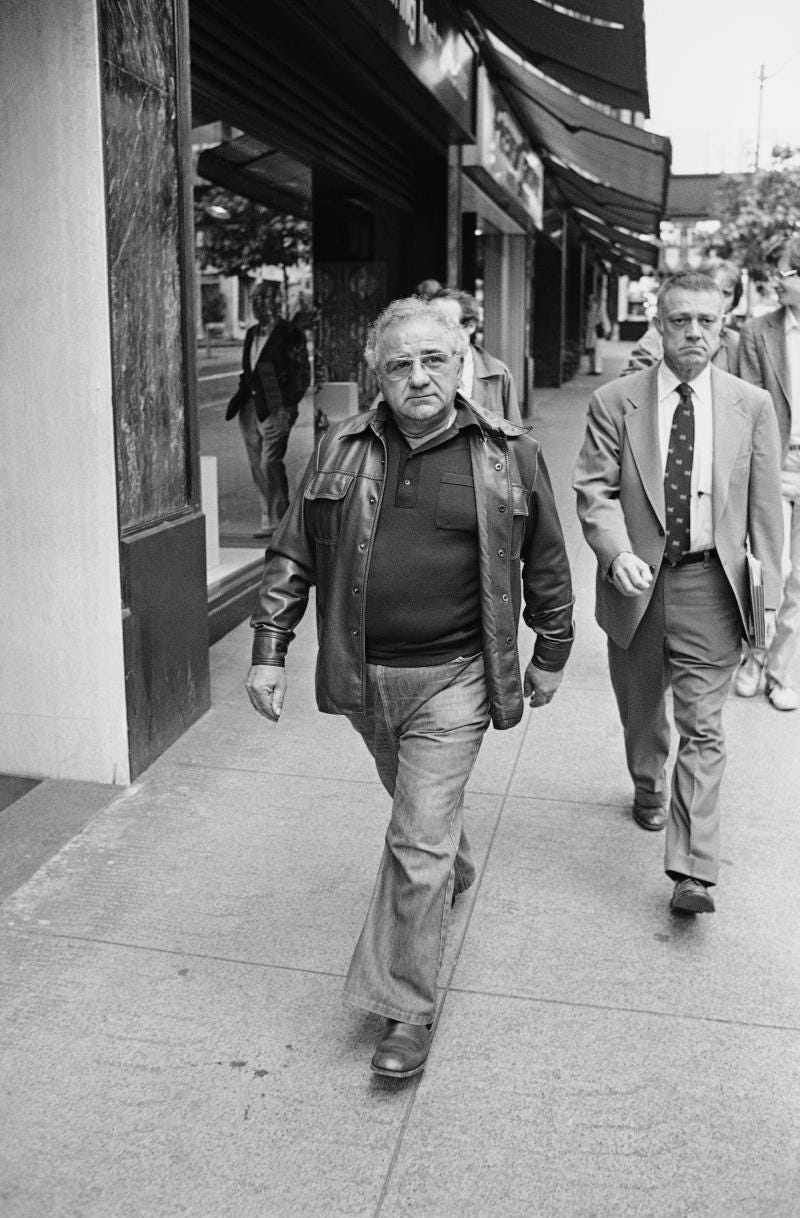
The Colacurcio’s had their fingers in everything!
Timo